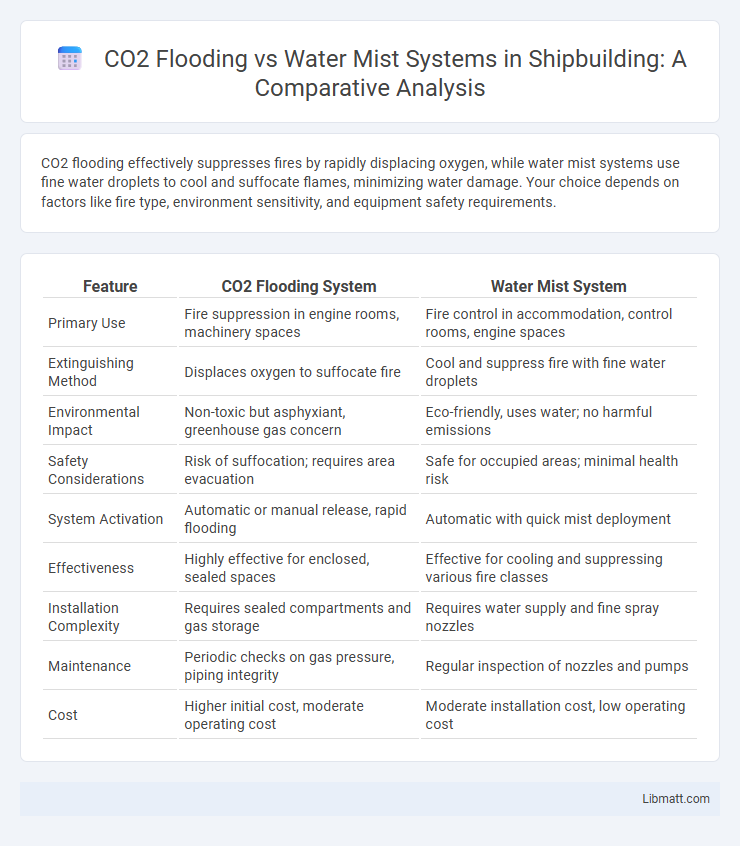CO2 flooding effectively suppresses fires by rapidly displacing oxygen, while water mist systems use fine water droplets to cool and suffocate flames, minimizing water damage. Your choice depends on factors like fire type, environment sensitivity, and equipment safety requirements.
Table of Comparison
| Feature | CO2 Flooding System | Water Mist System |
|---|---|---|
| Primary Use | Fire suppression in engine rooms, machinery spaces | Fire control in accommodation, control rooms, engine spaces |
| Extinguishing Method | Displaces oxygen to suffocate fire | Cool and suppress fire with fine water droplets |
| Environmental Impact | Non-toxic but asphyxiant, greenhouse gas concern | Eco-friendly, uses water; no harmful emissions |
| Safety Considerations | Risk of suffocation; requires area evacuation | Safe for occupied areas; minimal health risk |
| System Activation | Automatic or manual release, rapid flooding | Automatic with quick mist deployment |
| Effectiveness | Highly effective for enclosed, sealed spaces | Effective for cooling and suppressing various fire classes |
| Installation Complexity | Requires sealed compartments and gas storage | Requires water supply and fine spray nozzles |
| Maintenance | Periodic checks on gas pressure, piping integrity | Regular inspection of nozzles and pumps |
| Cost | Higher initial cost, moderate operating cost | Moderate installation cost, low operating cost |
Introduction to Fire Suppression Technologies
CO2 flooding systems use carbon dioxide gas to rapidly displace oxygen, effectively extinguishing fires in enclosed spaces by suffocating flames. Water mist systems release fine water droplets that cool the fire and reduce heat, limiting oxygen availability while minimizing water damage. Your choice between these fire suppression technologies depends on the protected environment, sensitivity of equipment, and specific fire risks involved.
How CO₂ Flooding Systems Work
CO2 flooding systems inject carbon dioxide directly into reservoirs to increase oil recovery by reducing oil viscosity and improving flow. The injected CO2 dissolves in the oil, causing it to swell and release trapped hydrocarbons, enhancing extraction efficiency compared to traditional methods. Your choice of a CO2 flooding system depends on reservoir characteristics and the ability to maintain adequate pressure for optimal performance.
Water Mist Systems: An Overview
Water mist systems utilize fine water droplets to suppress fires by cooling and oxygen displacement, offering rapid fire control with minimal water usage. Unlike CO2 flooding, which relies on gas to reduce oxygen levels and extinguish flames, water mist systems provide localized, environmentally friendly suppression, reducing damage to equipment. These systems are especially effective in enclosed spaces where sensitive electronics require protection without residue or corrosive effects.
Key Differences Between CO₂ and Water Mist Systems
CO2 flooding systems utilize carbon dioxide gas to displace oxygen, rapidly extinguishing fires in enclosed spaces, while water mist systems release fine water droplets that cool flames and reduce heat through evaporation. CO2 systems are ideal for electrical and flammable liquid fires due to their non-conductive and residue-free nature, whereas water mist systems are more effective for class A fires and provide additional cooling benefits with minimal water damage. Installation complexity and environmental impact differ significantly; CO2 systems require airtight areas to prevent gas leakage, while water mist systems offer safer application in occupied spaces with reduced environmental concerns.
Effectiveness Against Various Fire Classes
CO2 flooding systems excel in suppressing Class B and Class C fires by displacing oxygen and interrupting the combustion process without leaving residue. Water mist systems are highly effective against Class A fires, rapidly cooling and suppressing flames while minimizing water damage. Both systems offer targeted fire suppression, but their effectiveness varies based on the fire class and environment.
Safety Considerations and Human Occupancy
CO2 flooding systems pose significant risks due to the displacement of oxygen, creating a hazardous environment for human occupancy without proper evacuation protocols and monitoring sensors. Water mist systems offer enhanced safety by reducing oxygen depletion and minimizing respiratory hazards, allowing for safer human presence during and after discharge. Your choice between these fire suppression methods should prioritize occupant safety and compliance with safety standards in enclosed spaces.
Environmental Impact and Regulations
CO2 flooding systems and water mist systems differ significantly in environmental impact and regulatory considerations. CO2 flooding involves the controlled release of carbon dioxide, which must comply with strict greenhouse gas emission regulations and monitoring requirements to mitigate climate change effects. Water mist systems, relying on fine water droplets, pose minimal environmental risk and typically face fewer regulatory constraints, making them a more eco-friendly option for fire suppression in many settings.
Installation and Maintenance Requirements
CO2 flooding systems require complex installation involving high-pressure piping, storage tanks, and specialized detection sensors to ensure safe operation, often demanding professional expertise and significant upfront costs. Maintenance includes regular inspection of pressurized components, leak detection, and refilling CO2 cylinders, which can be labor-intensive and costly over time. Water mist systems, in contrast, feature simpler installation with low-pressure piping and smaller pumps, while maintenance primarily involves nozzle cleaning and routine system checks, resulting in lower operational expenses and easier upkeep.
Cost Comparison: CO₂ vs Water Mist
CO2 flooding systems generally incur higher initial installation and operational costs due to the need for pressurized gas cylinders and specialized discharge piping. Water mist systems offer a more cost-effective solution with lower installation expenses and reduced water usage, making maintenance simpler and less costly. Your choice depends on balancing the upfront investment against long-term operational efficiency and effectiveness in fire suppression.
Choosing the Right System for Your Application
CO2 flooding offers high efficiency in fire suppression for enclosed industrial spaces by rapidly displacing oxygen, making it ideal for areas with sensitive equipment. Water mist systems use fine water droplets to absorb heat and control fires while minimizing water damage, suitable for occupied spaces and environments requiring safe residue-free solutions. Assessing your facility's specific hazards, occupancy, and equipment sensitivity will help you determine the best fire suppression method to protect your assets effectively.
CO2 flooding vs water mist system Infographic

 libmatt.com
libmatt.com